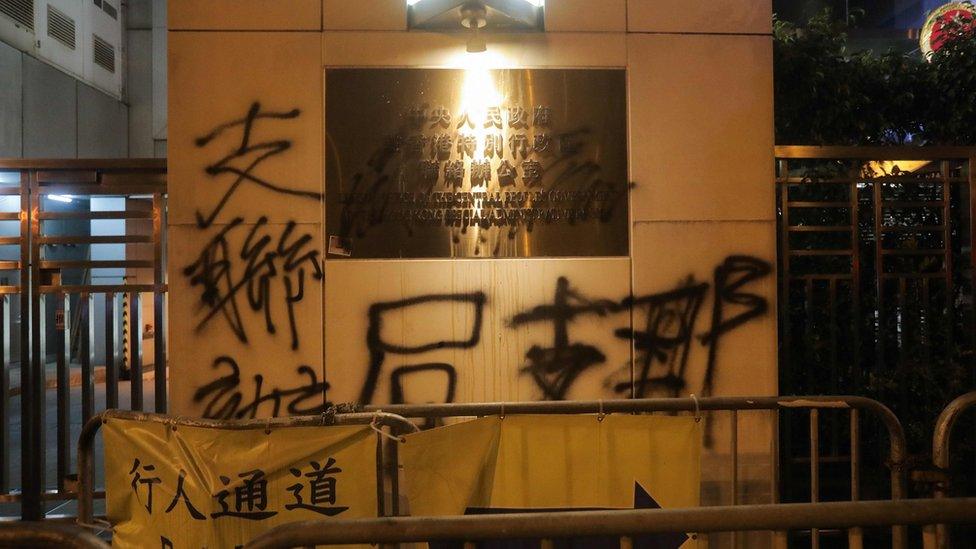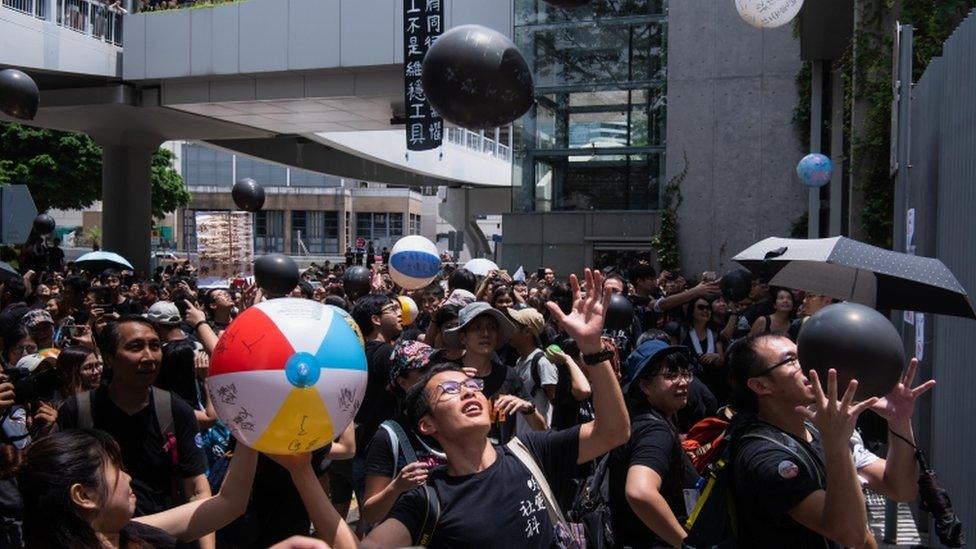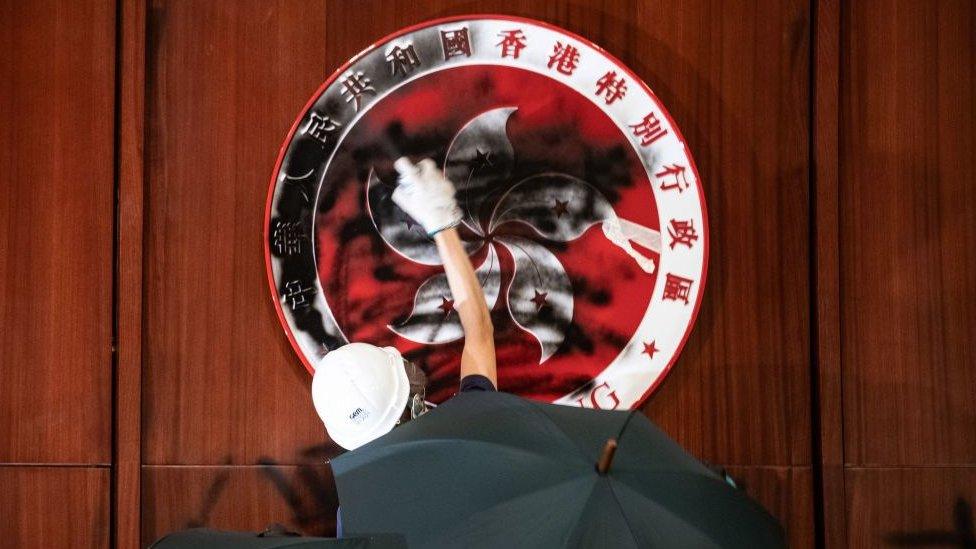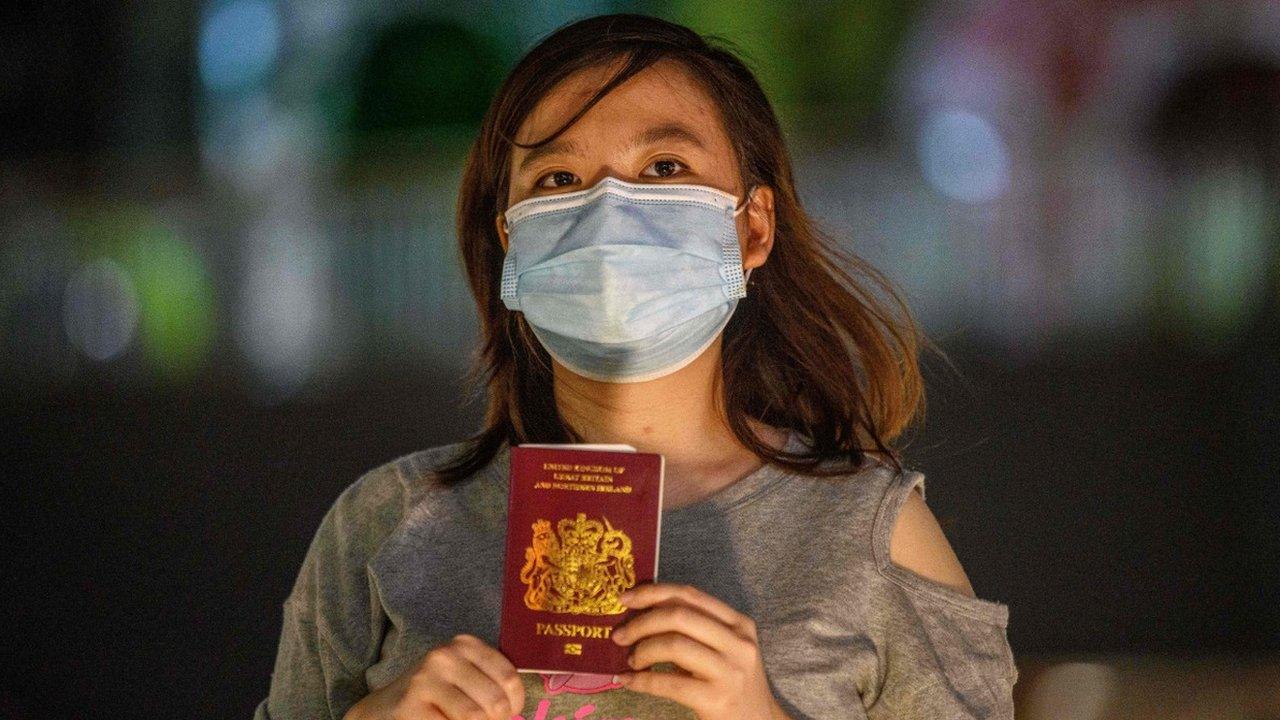Hong Kong protests: Police fire tear gas at demonstrators
- Published
Tear gas fired at Hong Kong pro-democracy protest
Riot police have fired tear gas and rubber bullets at protesters in Hong Kong following a large pro-democracy rally in the city.
Officers charged demonstrators who threw objects at police lines.
The clashes came after marchers ignored a designated finish line, continuing on to China's central government offices and throwing eggs at the building.
Organisers of Sunday's protest say more than 430,000 people took part but police put the figure at 138,000.
Mass protests have been held for weeks, initially over an extradition deal with mainland China but now covering other issues on democracy in Hong Kong.
Late on Sunday, riot police equipped with masks and shields were seen swarming towards protesters close to a ferry terminal on the main island.

Protesters threw eggs at the Liaison office's sign on Sunday
Images outside of the liaison office, China's central government building, show signs covered in graffiti. One of the slogans reads: "You taught us peaceful marches are useless."
Some protesters also covered the CCTV cameras outside a police station with spray paint.
A number of pro-democracy protesters were later attacked by masked men inside Yuen Long metro station in the north of Hong Kong.
Video footage from the scene show the group hitting people with sticks.
Allow X content?
This article contains content provided by X. We ask for your permission before anything is loaded, as they may be using cookies and other technologies. You may want to read X’s cookie policy, external and privacy policy, external before accepting. To view this content choose ‘accept and continue’.
At least 36 people were taken to hospital following the incident, local media reports., external
The latest rally was put on edge after a huge haul of explosives was found along with protest leaflets.
On Saturday, a counter-rally in support of the police and against protest violence drew tens of thousands.
Tear-gas, rubber bullets, the trashing of parliament by protesters and sporadic clashes have created the worst crisis in the territory's recent history.
The Hong Kong government has since suspended trying to pursue the extradition bill.
The BBC's Stephen McDonell was amid the pro-democracy protesters as tear gas began to be fired
The former British colony is part of China but run under a "one country, two systems" arrangement that guarantees it a level of autonomy. It has its own judiciary, and a legal system that is independent from mainland China.
What happened on Sunday?
Sunday's protests marked the seventh consecutive weekend of mass demonstrations in Hong Kong.

The pro-democracy protests show little sign of abating
The protest route was altered with protesters told to stop at Wan Chai rather than Central, where the key government offices are located.
Some 4,000 police officers were deployed.
Bonnie Leung from the Civil Human Rights Front urged Hong Kong leader Carrie Lam to "stop turning a deaf ear to the Hong Kong people's demands".
She told reporters after the march: "Carrie Lam really needs to respond and I hope we will see that soon."
Previous marches have also largely been peaceful, but have sparked violence on the fringes. Last weekend's protests left 28 people, including 13 police officers, injured.
Is the explosives find linked?
Hong Kong police are still investigating. Three men are under arrest.
Officers discovered the haul when they entered an industrial building in the Tsuen Wan district on Friday evening.
They said they found 2kg (4.4lb) of the highly volatile TATP, as well as 10 petrol bombs, acidic substances, weapons including knives and metal rods, and gas masks and goggles.
There were also banners and leaflets opposing the extradition bill and a T-shirt bearing the logo of the pro-independence Hong Kong National Front group.
What was the counter-protest about?
It took place in the central Hong Kong district of Admiralty on Saturday, attracting 103,000 people according to police, but more than 300,000 according to organisers.
"You are fake news" - BBC correspondent heckled live on air during Saturday's rally
It was themed "Safeguard Hong Kong". The South China Morning Post, external said attendees included locals, mainland immigrants, members of ethnic minorities and visitors from across the border.
The rally, which won coverage in Chinese state media, focused on support for the police and condemnation of the violence that has marred pro-democracy rallies.
Views differed, however, on how the Hong Kong government had tackled the crisis.
How did the protests start?
They were sparked by the proposed extradition bill that would have allowed people to be sent to China for trial.
Critics said it would undermine Hong Kong's judicial independence and could be used to target those who spoke out against the Chinese government.
The Hong Kong government suspended the bill, but this has not halted the demonstrations, which now reflect broader demands for democratic reform and concerns that freedoms are being eroded.
Hong Kong's Chief Executive Carrie Lam has said there is "no plan" to continue with the bill but this has not convinced critics
- Published21 May 2020

- Published2 July 2019

- Published20 July 2020
